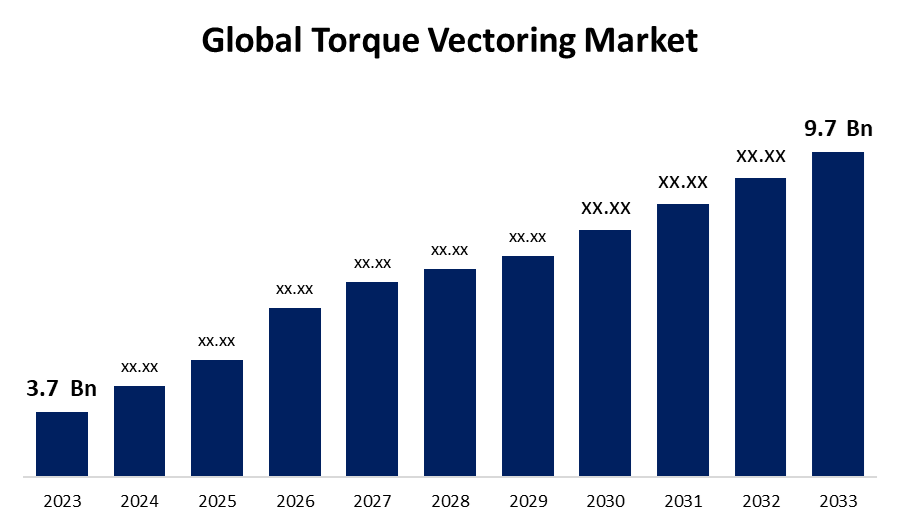Global Torque Vectoring Market Size Worth To USD 9.7 Billion by 2033 | CAGR of 10.12%
Category: Automotive & TransportationGlobal Torque Vectoring Market Size Worth To USD 9.7 Billion by 2033
According to a research report published by Spherical Insights & Consulting, The Global Torque Vectoring Market Size to Grow from USD 3.7 Billion in 2023 to USD 9.7 Billion by 2033, at a Compound Annual Growth Rate (CAGR) of 10.12% during the forecast period.

Get more details on this report -
Browse key industry insights spread across 250 pages with 100 Market data tables and figures & charts from the report on the "Global Torque Vectoring Market Size, Share, and COVID-19 Impact Analysis, By Vehicle Type (Passenger cars, Commercial Vehicles), Propulsion Type (Front Wheel Drive, Rear Wheel Drive, All Wheel Drive (AWD)/Four Wheel Drive (4WD)), Technology Type (Active Torque Vectoring, Passive Torque Vectoring), and By Region (North America, Europe, Asia-Pacific, Latin America, Middle East, and Africa), Analysis and Forecast 2023 - 2033." Get Detailed Report Description Here: https://www.sphericalinsights.com/reports/torque-vectoring-market
The torque vectoring market is witnessing consistent growth, driven by the rising demand for enhanced vehicle safety, performance, and handling especially in luxury and high-performance segments. This technology enables precise power distribution to individual wheels, boosting traction, cornering capabilities, and overall driving dynamics. The growing popularity of electric and hybrid vehicles further accelerates adoption, as torque vectoring is essential for managing electric motor outputs to ensure smoother, more efficient operation. Automakers are increasingly investing in advanced drivetrain technologies to stand out in a competitive market, particularly in premium and sports models. Additionally, evolving consumer expectations for improved control and stability, along with stricter vehicle safety regulations, are encouraging wider integration of torque vectoring systems. As a result, the market is expanding steadily across both OEM and aftermarket channels worldwide.
Torque Vectoring Market Value Chain Analysis
The torque vectoring market value chain involves several interrelated stages, beginning with raw material suppliers who provide key components such as sensors, actuators, electronic control units, and drivetrain elements. These parts are then used by component manufacturers to design and produce torque vectoring modules customized for different vehicle platforms. Tier 1 suppliers and system integrators assemble these modules into complete systems and work closely with automotive OEMs to integrate them into specific vehicle models. OEMs oversee testing, validation, and customization to meet individual model requirements. After production, vehicles are distributed through dealership networks, while aftermarket providers manage maintenance, upgrades, and component replacements. Research institutions and technology partners play a vital role in advancing innovation, particularly in software and control systems. Regulatory bodies ensure compliance with safety and performance standards, shaping development and guiding market trends.
Torque Vectoring Market Opportunity Analysis
The torque vectoring market offers substantial growth opportunities, fueled by shifting automotive trends and rapid technological progress. With the industry's move toward electrification, torque vectoring systems are becoming essential for improving vehicle performance, safety, and energy efficiency. Electric powertrains enable more precise torque distribution, enhancing traction and handling. Increasing demand for luxury and high-performance vehicles also drives the adoption of torque vectoring, allowing automakers to stand out through superior driving dynamics. Furthermore, the advancement of autonomous and connected vehicles creates new possibilities for integrating torque vectoring with advanced driver-assistance systems, boosting stability and control. Emerging markets, especially in the Asia-Pacific region, are seeing rising adoption, supported by evolving consumer preferences and favorable regulatory environments, further contributing to the market’s expansion.
The torque vectoring market is experiencing strong growth, largely driven by increasing demand for enhanced vehicle performance. As both consumers and manufacturers focus more on improved handling, stability, and safety, the use of torque vectoring systems is expanding across a wide range of vehicle categories. These systems are essential for efficiently distributing power between wheels, leading to improved traction and superior cornering capabilities. Automakers are adopting advanced torque vectoring technologies to cater to drivers who desire a more dynamic and responsive driving experience. The growing popularity of electric and hybrid vehicles has further accelerated this trend, as these powertrains greatly benefit from accurate torque control. Moreover, continuous advancements in automotive electronics and control systems are making torque vectoring solutions more effective and adaptable, fueling ongoing market growth.
One of the key challenges facing the torque vectoring market is the high cost of implementation, particularly in luxury and high-performance vehicles. Integrating advanced torque vectoring systems involves complex hardware and software, which raises manufacturing expenses and, consequently, vehicle prices. The intricate nature of these systems also leads to increased maintenance and repair costs, potentially deterring some consumers. Additionally, the lack of standardization in torque vectoring technologies can cause compatibility issues across various vehicle platforms. The market also faces obstacles due to the slower pace of electric vehicle adoption in certain regions, despite EVs benefiting significantly from torque vectoring capabilities. Moreover, the technology’s dependence on precise sensors and control mechanisms can reduce its effectiveness in harsh weather conditions or challenging terrain.
Insights by Vehicle Type
The passenger car segment accounted for the largest market share over the forecast period 2023 to 2033. With consumers prioritizing enhanced handling, stability, and safety, automakers are steadily integrating torque vectoring systems into passenger cars. These systems significantly improve traction, cornering precision, and overall driving dynamics features that are particularly prized in luxury and high-performance vehicles. The increasing shift toward electric and hybrid vehicles further supports the adoption of torque vectoring, as these platforms gain from accurate and efficient power distribution. As customer expectations evolve, manufacturers are ramping up investments in advanced technologies to meet the growing demand for vehicles that combine strong performance with enhanced safety. This continued focus is driving the expansion of torque vectoring systems across the passenger car segment.
Insights by Propulsion Type
The All-Wheel Drive (AWD) and Four-Wheel Drive (4WD) segment accounted for the largest market share over the forecast period 2023 to 2033. Torque vectoring systems significantly improve handling, stability, and traction by efficiently distributing torque to individual wheels, especially under diverse driving conditions. The growing popularity of SUVs, off-road vehicles, and electric vehicles (EVs) is accelerating the adoption of AWD and 4WD systems, due to their enhanced performance and safety capabilities. Innovations such as electronic clutch actuation and the integration of these systems with advanced driver assistance systems (ADAS) are further increasing their attractiveness. As consumer preferences continue to favor vehicles that deliver superior driving dynamics and safety, the AWD/4WD segment is expected to see sustained growth within the torque vectoring market.
Insights by Technology Type
The passive torque vectoring segment accounted for the largest market share over the forecast period 2023 to 2033. Passive torque vectoring systems (PTVS) rely on mechanical elements, such as limited-slip differentials and braking mechanisms, to distribute torque between wheels. This enhances vehicle stability and handling without the added complexity of electronic controls. The straightforward design makes PTVS an appealing choice for automakers looking to boost performance while keeping production costs in check. While active torque vectoring systems are gaining traction in high-performance and electric vehicles, PTVS remains relevant due to its affordability and proven reliability. As the automotive industry continues to emphasize cost-efficiency and simplicity, passive torque vectoring is expected to maintain a steady presence, particularly in vehicle segments where advanced electronics are less common.
Insights by Region
North America is estimated to hold the largest share of the pharmaceutical ethanol market over the forecast period.

Get more details on this report -
North America is anticipated to dominate the Torque Vectoring Market from 2023 to 2033. Rising consumer demand for enhanced handling and dynamic driving experiences is prompting automakers to incorporate torque vectoring systems across a range of vehicles, from sports cars to SUVs. The focus on performance, along with increasing safety regulations, continues to drive adoption. Significant opportunities exist in the integration of torque vectoring with electric and hybrid vehicles, as well as within the aftermarket segment. In North America, the U.S. remains the dominant market, while Canada and Mexico are also witnessing steady growth in the implementation of torque vectoring technologies.
Asia Pacific is witnessing the fastest market growth between 2023 to 2033. The growth of the market is largely fueled by the rising adoption of electric vehicles (EVs), especially battery electric vehicles (BEVs), which gain considerable advantages from torque vectoring systems that improve both performance and efficiency. Countries such as China, Japan, and India are at the forefront of this shift, with China surpassing its EV adoption targets ahead of schedule. Supportive government initiatives and policies promoting EV usage, along with ongoing technological advancements in torque vectoring systems, are further accelerating market expansion across the region.
Recent Market Developments
- In August 2023, Lamborghini unveiled the Lamborghini Lanzador, a two-door crossover concept that runs entirely on electricity, marking the brand’s debut in the electric vehicle market.
Major players in the market
- Delphi Technologies
- Honda Motor Co
- Nissan Motor Corporation
- Trelleborg AB
- Continental AG
- Magna International
- RenaultNissanMitsubishi Alliance
- ZF Friedrichshafen
- Aisin Seiki
- Toyota Motor Corporation
- Voith GmbH
- Hyundai Mobis
- Daimler AG
- GKN Automotive
- BorgWarner
Market Segmentation
This study forecasts revenue at global, regional, and country levels from 2023 to 2033.
Torque Vectoring Market, Vehicle Type Analysis
- Passenger cars
- Commercial Vehicles
Torque Vectoring Market, Propulsion Type Analysis
- Front Wheel Drive
- Rear Wheel Drive
- All Wheel Drive (AWD)/Four Wheel Drive (4WD)
Torque Vectoring Market, Technology Type Analysis
- Active Torque Vectoring
- Passive Torque Vectoring
Torque Vectoring Market, Regional Analysis
- North America
- US
- Canada
- Mexico
- Europe
- Germany
- Uk
- France
- Italy
- Spain
- Russia
- Rest of Europe
- Asia Pacific
- China
- Japan
- India
- South Korea
- Australia
- Rest of Asia Pacific
- South America
- Brazil
- Argentina
- Rest of South America
- Middle East & Africa
- UAE
- Saudi Arabia
- Qatar
- South Africa
- Rest of the Middle East & Africa
About the Spherical Insights & Consulting
Spherical Insights & Consulting is a market research and consulting firm which provides actionable market research study, quantitative forecasting and trends analysis provides forward-looking insight especially designed for decision makers and aids ROI.
Which is catering to different industry such as financial sectors, industrial sectors, government organizations, universities, non-profits and corporations. The company's mission is to work with businesses to achieve business objectives and maintain strategic improvements.
CONTACT US:
For More Information on Your Target Market, Please Contact Us Below:
Phone: +1 303 800 4326 (the U.S.)
Phone: +91 90289 24100 (APAC)
Email: inquiry@sphericalinsights.com, sales@sphericalinsights.com
Contact Us: https://www.sphericalinsights.com/contact-us
Need help to buy this report?